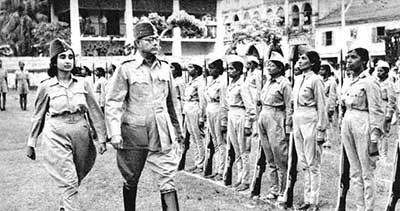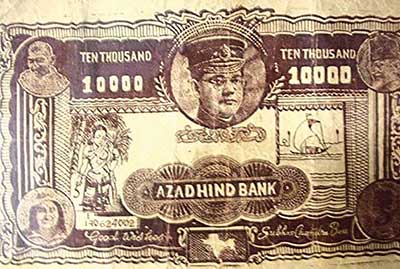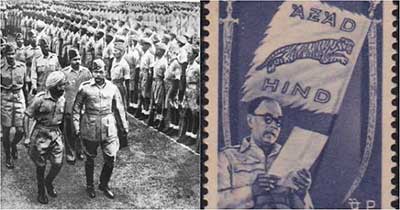Symbol of valour of Azad Hind Fauz
The Azad Hind Government, founded on 21st October, 1943 was inspired by Neta ji Subhash Chandra Bose who was the leader of Azad Hind Government and also the Head of State of this Provisional Indian Government-in-exile.
Subhash Chandra Bose declared the formation of the provisional government of Azad Hind and the names of the cabinet members who signed the proclamation.
Members of cabinet of Azad hind fauz :

Subhash Chandra Bose : Head of the state, Prime minister and Minister for war, foreign Affairs and supreme commander of the INA
- Lt Col A C Chatterjee : Minister of Finance
- Dr (Capt) Lakshmi Sahgal : Minister of Women’s Organisation
- Shri A M Sahay : Secretary with Ministerial Rank
- Shri S A Ayer : Minister of Publicity and Propaganda
- Lt Col J K Bhonsle: Representative of INA
- Lt Col Loganathan: Representative of INA
- Lt Col Ehsan Qadir: Representative of INA
- Lt Col N S Bhagat: Representative of INA
- Lt Col M Z Kiani: Representative of INA
- Lt Col Aziz Ahmed: Representative of INA
- Lt Col Shah Nawaz Khan: Representative of INA
- Lt Col Gulzara Singh: Representative of INA
- Rash Behari Bose: Supreme Advisor
- Karim Giani: Advisor from Burma
- Debnath Das: Advisor from Thailand
- Sardar Ishar Singh: Advisor from Thailand
- D M Khan : Advisor from Hong Kong
- A Yellappa: Advisor from Singapore
- A N Sarkar: Advisor from Singapore
Bose also established a military hierarchy in Azad Hind Fauj – Lt Col Shah Nawaz Khan was the Chief of General Staff, Major PK Sahgal was the Military Secretary, and Major Habib ur Rahman was the Commandant of officers’ training school. The INA also had an all-women regiment called “Rani of Jhansi Regiment”.
Under the command of Captain Lakshmi Sahgal, the Rani of Jhansi Regiment became an important and integral part of the INA, despite the scepticism of many, including the Japanese, who had provided crucial assistance in Bose’s fight against the Raj.

Azad hind fauz was a part of the freedom movement, originating in 1940s outside India with a purpose of allying with Axis powers to free India from British rule. The existence of the Azad Hind Government gave a greater legitimacy to the independence struggle against the British. Pertinently, the role of Azad Hind Fauj or the Indian National Army (INA) had been crucial in bequeathing a much needed impetus to India’s struggle for Independence. By April 1944, the Azad Hind Bank was established in Rangoon to manage the overwhelming donations from the Indian communities.

Estimates say that under Bose, the strength of Azad Hind Fauj rose, once again, to 40,000 soldiers. Azad Hind Fauj participated in two military encounters during the Second World War – in Arakan in Burma (now Myanmar) in January-February 1944 and in Imphal in Manipur in March 1944.
Netaji Subhash Chandra Bose unfurled the Tricolor in Port Blair on 30th December 1943 and declared Andaman and Nicobar Islands to be the first Indian Territory to be freed from British Raj. On 6th November 1943, the then Prime Minister of Japan had declared in the Tokyo Assembly of Greater East Asiatic Nations that the Andaman and Nicobar Islands would be transferred to the provisional Government, Azad Hind. The Japanese imperial forces were in occupation of these islands from 23rd March 1943 during the World War.
In April 1944, the Azad Hind Fauj under the leadership of Col. Shaukat Malik had unfurled the Tricolour in Moirang of Manipur.







